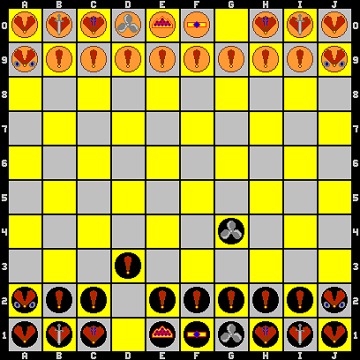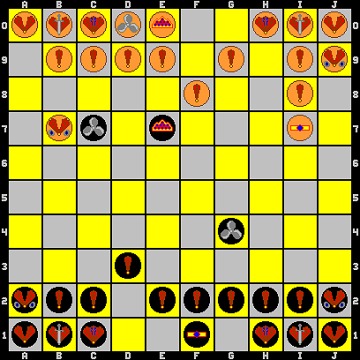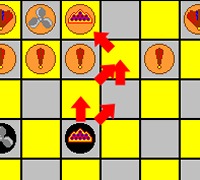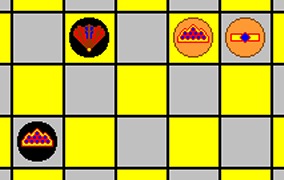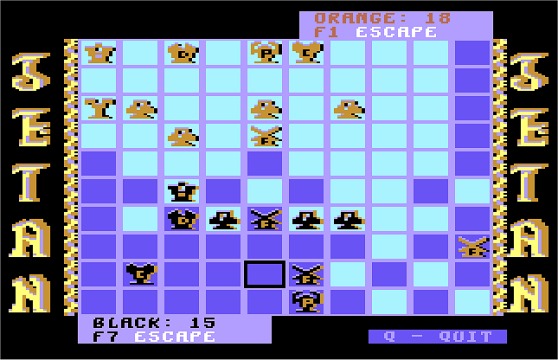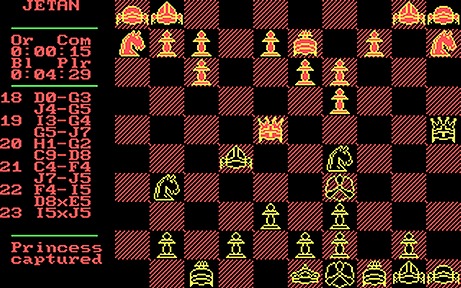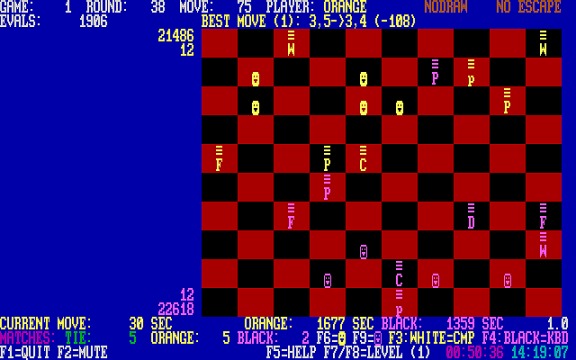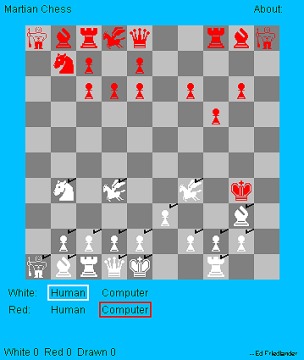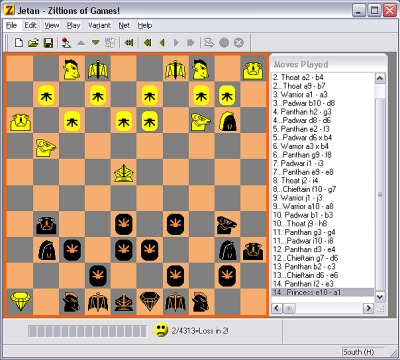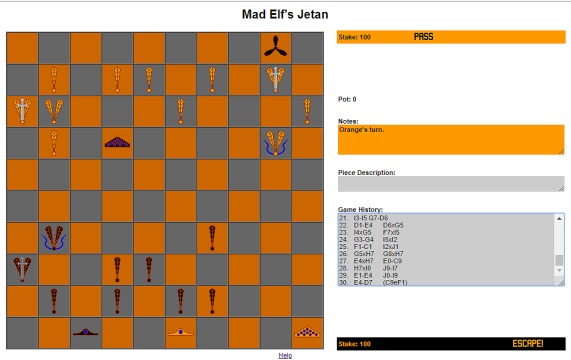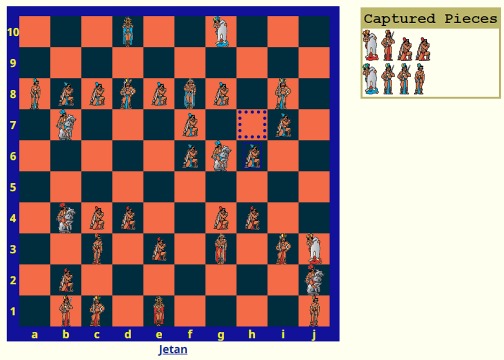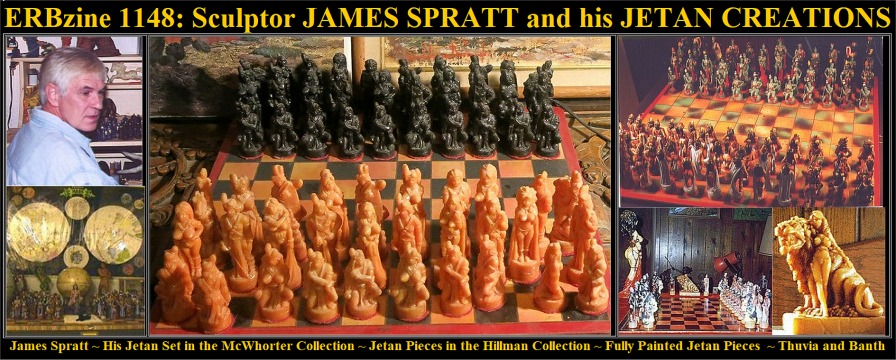. 
Official Edgar Rice Burroughs Tribute and Weekly Webzine Site
Since 1996 ~ Over 15,000 Web Pages in Archive
Presents
Volume 7030
Exploring Jetan
By Fredrik Ekman
This article is based on “Some Thoughts about Jetan”,
originally published in ERB-APA #92 and #94 (2007).
It has been heavily extended and revised.
See THE RULES OF JETAN at 7030a
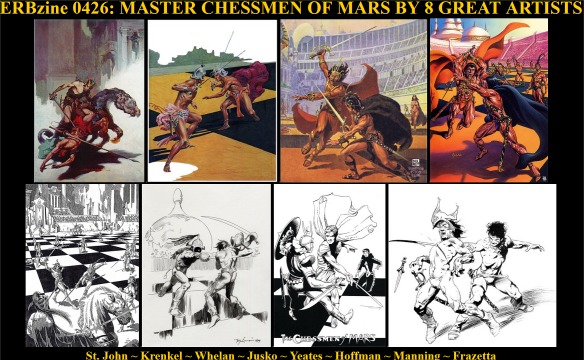
Click for full-size collage
The chess-like game jetan has, ever since its 1922 appearance in The Chessmen of Mars, captured the imagination and fascination of Edgar Rice Burroughs’ readers. It has been the subject of many paintings and other illustrations; it has been featured in comic books, in professional pastiche, and in fan fiction; it has even been made into music by Swedish avant-garde composer Sten Hanson. And, of course, countless fans have tried to play it. This chess variant has even spawned its own variants, with additional pieces, invented by L. Lynn Smith, Joe Ferrier and James Killian Spratt. The most over-the-top variant is Spratt’s humongous Jetan Jeddara, which is played on an oversized board with over one hundred pieces.The current (2019) version of the Wikipedia article about the game begins: “Jetan, also known as Martian Chess, is a chess variant with unclear rules.” As if unclear rules was the most important point to make. Fortunately, there are much more interesting aspects than that, and as we shall see, the rules do not even need to be unclear. The main purpose of this article is to analyse jetan, as it was described by Burroughs, in order to clarify the rules.
Burroughs’ Purpose with Jetan
Burroughs said that he only wanted to tell an exciting story, and the evidence bears him out. Elements of theme, character and analogy each has its place in his stories, but almost any important object or concept introduced can be traced to a furthering of the plot. That is certainly the case with jetan.Jetan has many functions for advancing the plot of The Chessmen of Mars. In the first place, the memory of jetan prompts John Carter to tell the story. This beginning, the rules in Chapter Two, and the descriptions of how jetan permeates the Manatorian culture, all lead up to the climactic jetan game in Chapter Seventeen, one of the most important chapters. After a few relatively quiet chapters, it delivers intense action and sets the scene for the coming revolt.
Burroughs’ characters had to fit into his elaborate plots, so he made heavy use of stereotypes. Some of the most common ones were the hero, the villain, the damsel in distress and the hero’s sidekick. The jetan board is made to accommodate these and a host of the usual, nameless and dispensable allies and henchmen.
The stereotypes are well modelled by the rules for the pieces they incorporate. The hero is, naturally, the Chief – Gahan of Gathol. He is fast and powerful. Only the villainous U-Dor, the other Chief, has comparable attributes, but his lack of will and courage makes him no match for the determined hero. The damsel, on the other hand, is weak and frail. As the Princess, she cannot fight, but when she must she can take care of herself by running away. The sidekicks (two of them, in fact: the Odwars (Fliers)) are also powerful, although not quite to the extent that the hero is. Like the usual Burroughs sidekick, they display no initiative of their own. They follow the hero’s lead and do his bidding.
This explains the somewhat strange jetan set-up, with the powerful pieces concentrated in the centre and the weaker pieces flanking: The major characters have to be close together for dramatic purposes.
It also partly explains the often criticised rule that when the Chief is taken by any other piece than the enemy Chief, the game is drawn: The game, like the book, centres around the conflict between hero and villain. If either is dead, the game is pointless. At the same time, a minor character slaying a Chief would be very anticlimactic. So a Chief can only be slain by another Chief in order to uphold the drama. Rick Johnson explains this very well in his jetan article.
Another, perhaps stronger, reason for that rule is of a more specific nature. When Gahan threatens U-Dor near the end of the game, Burroughs needs to convincingly display U-Dor’s cowardice. He does this through a rule-induced dilemma. Either U-Dor can be brave and risk everything to win, or he can be a coward and risk someone else’s life to draw.
Taylor Kingston has remarked that Burroughs was not an experienced gamer, and I agree. Burroughs stated in a Writer’s Digest article that “I have successfully avoided the acquisition of any sort of a hobby.” He further said that “it is better to have a little knowledge of many things than an expert knowledge of one,” and I take this to read that while he may have enjoyed a game of chess every once in a while, he never spent any considerable energy in mastering it, nor any other game (except maybe poker and bridge).
Jetan is “only” a literary device, used to forward the plot and to reinforce the hero’s traits of righteousness, good judgement and bravery, whereas the villain receives a dose of the opposite. Considering this, jetan is a surprisingly playable game and very well, if delicately, balanced.
Variants of Jetan
Jetan has always been played a little differently by different fans, due to the ambiguities inherent in Burroughs’ rules. About the year 2000, L. Lynn Smith presented an excellent analysis of jetan on his web site The Rules of Jetan, where most conceivable options for the various pieces’ moves are discussed. The site was – and to some extent remains – instrumental in defining how jetan can be interpreted. The reader of this article will find it beneficial, although not necessary, to have at least a superficial understanding of Smith’s work and the terminology he uses. Any use I make of Smith’s terminology will be in capital letters.Smith introduces different interpretations of piece movements as variants, without advocating one specific variant. On the contrary, he has argued on the Jetan mailing list that jetan should be considered a game of variants, rather than a game with variants. All the permutations from Smith’s site combine to a staggering 414,720 possible variants, not counting the variants with additional pieces.
Hundreds of thousands of variants is certainly not what Burroughs intended! In fact, he suggests that jetan is played in exactly the same way in most nations. That is why John Carter and Pan Dan Chee, representing societies separated for ages, can decide to play without negotiating the rules (LG Part 1, Ch. 6). That is also why both Tara (CM/13) and Gahan (CM/16) are surprised to learn about the variant rules that do exist in Manator. Besides, if there are jetan variants on Barsoom, those variants are surely not the ones caused by our imperfect understanding of the rules.
So, does it matter which rules people use to play? Of course not, as long as the rules are already known and agreed upon. However, a player new to the game will, starting from Smith’s description, have to learn not only one set of moves for each piece, but several – sometimes as many as six. That is not the way to attract new players! And whenever you want to play a game of jetan; whenever someone wants to stage a tournament; whenever there is a discussion about tactics, none of this can happen before the participants have negotiated the rules. Provided that they can agree at all. This is not only cumbersome. It also hinders the future popularity of the game, because who wants to learn two to six variant moves for each piece before you can even start talking about playing?
In the following, I will take off from Smith’s analysis and attempt to find one set of rules.
But with 414,720 alternatives, how can we even begin to understand Burroughs’ intentions? Fortunately, it is not as bad as all that. To begin with, Burroughs used identical terms (and therefore identical ambiguities) for several pieces. This greatly reduces complexity. Furthermore, Smith and most other players naturally used one of the many book editions to extract the rules, but as we shall see, further clues exist in the original pulp magazine edition.
One final thing that works to our advantage is that Smith based his analysis on the rules in Chapter Two and in the Appendix of The Chessmen of Mars. There is also the above-mentioned game in Chapter Seventeen. This game introduces one new ambiguity of its own, but it also helps to straighten some things out.
Reconstructing a Play to the Death
I will now reconstruct the jetan game from the book’s seventeenth chapter. It has been analysed independently by Woodrow Edgar Nichols, Jr., who made a slightly different interpretation.All quotes in this section are from Chessmen, Chapter 17.
Burroughs described only the initial and concluding moves in detail, but most of those in between are suggested. I have retained Burroughs’ own, admittedly cumbersome, longhand descriptive method of notation, and in addition, I give the moves in the chess-inspired algebraic notation favoured by many players.
Gahan, our hero, played Black and U-Dor, a minor villain, played Orange. Before the game could begin, “the two sides took their places upon the black and orange squares of the great jetan board [...]. At [the Black Princess’] left was the Black Chief [...]; directly in front of her the Princess’ Panthan, [...]; and at her right the Princess’ Odwar [...].” The moves in the game show that the Orange pieces must be set up vertically mirrored, like in regular chess, so that Chiefs and Princesses face each other.
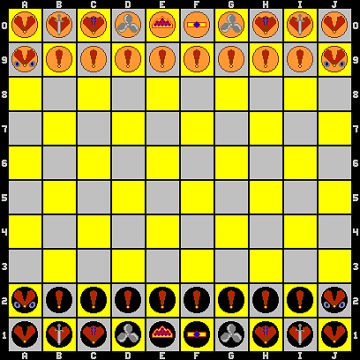
Jetan board - vertically mirrored set-upAlthough this matches Nichols’ analysis, it contradicts the rules in the Appendix, which specify that the pieces should be set up diametrally mirrored, i.e. the same as seen from each player.
Orange makes the first move, apparently after drawing lots. The fourteen moves are given with odd-numbered moves for Orange, even-numbered for Black.
One: “[Orange Chief] moved his Princess’ Odwar three squares diagonally to the right, which placed the piece upon the Black Chief’s Odwar’s seventh.” (G10–D7) The phrase “to the right” must be from the orange side’s perspective, i.e. west on the jetan board. This agrees with Nichols’ interpretation.
Two: “[Black Chief] followed with his Odwar’s Panthan one square straight forward”. (D2–D3) Nichols calls this move the “Gatholian Gambit”, although following normal chess terminology it is not a gambit at all.
Three: “[Orange Chief’s] next move placed [Orange Princess’] Odwar upon [Black Princess’] Odwar’s fourth”. (D7–G4)
Four: “Chief’s Odwar to Princess’ Odwar’s fourth!” (D1–G4) The ensuing fight is won by Black (in the arena version of jetan, a piece can only be taken by combat).
Five: Assumed. Orange Princess’ Panthan to Princess’ third. (F9–F8) Necessary to set the board up for the thirteenth move.
Six: Assumed. Black Princess’ Odwar to Princess’ fourth. (G1–F4) One of two possible moves that sets the board up for the eighth move. (Nichols leaves out four moves starting with this one.)
Seven: Assumed. Orange Princess’ Dwar’s Panthan to Princess’ Padwar’s third. (H9–I8) One of many possible Panthan moves at this point, and one of the more logical, opening up for the Dwar and Padwar.
Eight: Assumed. Black Princess’ Odwar to Chief’s Dwar’s seventh. (F4–C7) Burroughs says that Orange Princess’ “position had been threatened,” and this is the only possible move to threaten the Princess so soon, without hindering the Black Chief. Immediately advancing the Black Chief on move six, as Nichols indicates, does not threaten the Princess; in fact, in Nichols’ interpretation, the following Princess move makes her more threatened, instead of less.
Nine: Assumed. Orange Princess to Princess’ Padwar’s fourth. (F10–I7) Necessary to set the board up for the twelfth move. Nichols assumes this move to be an escape, but he has misread the distance between the pieces after move twelve below. His assumption places Gahan and Tara five squares apart (counting the square upon which Tara stands), not four, as the text says. Besides, his interpretation is illegal, since it places the Princess under threat from Black Chief’s Odwar.
Ten: Assumed. Black Chief to Chief’s Odwar’s fourth. (E1–E4) “It had been apparent to both players and spectators for the past two [Black] moves, that Gahan was moving straight across the field into the enemy’s country to seek personal combat with the Orange Chief”, Burroughs wrote after the twelfth move. This is the straightest of four possibilities to set up for that move, without threatening the Orange Princess.
Eleven: Assumed. Orange Chief’s Thoat to Chief’s Padwar’s fourth. (A9–B7) It would be logical for Orange to threaten the Black Odwar. This move does that.
Twelve: “The fourth [Black] move after the victory of the Black Odwar found [the Black Chief] upon [the Orange Chief’s] fourth [E4–E7]; an Orange Panthan was on the adjoining square diagonally to his right and the only opposing piece that could engage him other than [the Orange Chief] himself. [...] [The Orange Chief] could move out and engage [the Black Chief], or he could move his Princess’ Panthan upon the square occupied by Gahan in he hope that the former would defeat the Black Chief and thus draw the game, [...] [the Orange Chief] had placed his own Princess four squares east of [the Black Chief] when her position had been threatened, [...] [the Orange Chief] now discovered that he might play his own [remaining] Odwar into personal combat with [the Black Chief]”. The following diagram may differ slightly from Burroughs’ own game board, but not regarding any important details.
Thirteen: “There was just one hope [for the Orange Chief] and that lay in his Princess’ Panthan, so, without more deliberation he ordered the piece onto the square occupied by the Black Chief.” (F8–E7) The Black Chief easily won the contest. (U-Dor is in fact a very poor jetan player. In my diagram, there are two ways to temporarily block Black Chief and thereby gain time, either by moving Panthan on G9 or Dwar on H10. It is difficult to see how Orange can play the assumed moves above poorly enough to completely remove these opportunities.)
Fourteen: The Black Chief attacks and defeats the Orange Chief. (E7–E10)
The following table sums up the moves:
Move Orange Move Black 1 O G10–D7 2 PN D2–D3 3 O D7–G4 4 O D1–G4 (×) 5 *PN F9–F8 6 *O G1–F4 7 *PN H9–I8 8 *O F4–C7 9 *P F10–I7 10 *C E1–E4 11 *T A9–B7 12 C E4–E7 13 PN F8–E7 (-) 14 C E7–E10 (+) Assumed moves are marked by an asterisk. (×) means duel won by attacking player; (-) means duel won by defending player, something which never happens in standard jetan; (+) means game won by attacking player.
The conflicting information that opens up for Nichols’ interpretation is in Burroughs’ description of the ninth move (seventh in Nichols’ version). U-Dor made that move “when [Orange Princess’] position had been threatened, and he had hoped to lure the Black Chief after her and away from U-Dor”. This is conflicting because, on the one hand, in my interpretation the move is just plain silly if it is intended to “lure” Black Chief anywhere. On the other hand, in Nichols’ interpretation, her position is never “threatened” in any way before the move, and this seems to go even more against Burroughs’ description.
Another ambiguity is “The fourth move after the victory of the Black Odwar” (my twelfth move). I read this as the fourth black move (eighth by either player), Nichols as the fourth by either (second black). My position is stronger here because, in the next paragraph, Burroughs goes on to write about “the past two moves,” and it is obvious from the context that these have to be two black moves, not one move each. It stands to reason that Burroughs would use the same terminology in adjoining paragraphs.
Mine and Nichols’ readings are mutually incompatible, but only on the surface. We agree on the essential points: those that have an impact upon interpreting the rules.
Picking up the Pieces
With the aid of the above game, and some other passages from the novel text, we can now try to narrow down the number of variants. Remember, we start out with 414,720 possible variants, and we aim to get down to just one.Chapter Seventeen contains detailed descriptions of moves with two pieces, the Chief and the Odwar (normally called Flier in jetan).
The Chief is one of the pieces with the greatest number of alternatives in Smith’s analysis. The game’s fourteenth move can be made by either of two different paths (see diagram below). Neither path is possible if the Chief is either CHAINED, CHAINED CIVIL, FREE or FREE CIVIL. Only CHAINED WILD and FREE WILD remain as options. These differ as to whether the Chief has to move exactly three squares or if it could stop at one or two. This cannot be settled by analysing the game, but Burroughs gives a clue: ”Three squares is a Chief’s move—three squares in any direction or combination of directions, only provided that he does not cross the same square twice in a given move.” (CM/17) The information that no square may be crossed twice would have been pointless for a FREE WILD Chief (which can stop anywhere it pretty well pleases anyway). Thus, the Chief has to be CHAINED WILD. We are already down to 69,120 variants.
It is obvious from the very first move that the Odwar, unlike Jean-Louis Cazaux and others have claimed, is exactly the same piece as the Flier and it has the same jumping ability. In the game, three Odwar moves are described (first, second and fourth) and two others can be assumed (sixth and eighth). Two more Odwar moves are mentioned as possibilities: The first is at the fourth move, if Black were to lose then Orange “could move his [Odwar] on to the square occupied by [Black Princess]”; the second is before thirteenth, where Orange Chief “might play his own Odwar into personal combat with [Black Chief]”. Each of these seven moves is exactly three squares long, a strong indication (but not absolute proof) of a CHAINED rather than FREE Odwar (Flier).
But the strongest indication of a CHAINED interpretation comes from the Appendix. Compare the following quotes:
“Flier: [...] 3 spaces diagonal in any direction or combination”
“Chief: [...] 3 spaces in any direction; straight or diagonal or combination.”The two descriptions are almost identical, containing the words “3 spaces in any direction or combination”, and there is no reason to assume a CHAINED interpretation for one but not for the other. So, both Chief and Flier are CHAINED (augmented with WILD for the Chief). 34,560 variants remain.
Padwar and Dwar are, in Appendix as well as in Chapter Two, described using the same wording as Chief and Flier (“straight/diagonal in any direction or combination”). They must, by extension, also be CHAINED. 8,640 variants.
The Warrior is described differently in Chapter Two than in Appendix, which has caused some consternation among jetan players. However, the original pulp magazine version differs from the words in the book! Let us compare the three versions:
“straight in any direction, or combination, two spaces” (Chapter Two, pulp)
“straight in any direction, or diagonally, two spaces” (Chapter Two, book)
“2 spaces straight in any direction or combination.” (Appendix, both editions)The pulp version matches the Appendix version exactly, and the pulp version is also a much better match with the other piece descriptions in the same chapter. The infamous Warrior discrepancy, which has worried fandom for almost one hundred years, is simply based on a typographical error! The Warrior must, in analogy with Padwar and Dwar, be CHAINED. 1,440 variants.
The Panthan cannot be compared with the other pieces, since its limitation is in directions rather than spaces moved. Nor are there any clues in Chapter Seventeen. We must look at the possible purpose with the Panthan’s handicap. The CHAINED Panthan (no backward moves) is severely handicapped. The purpose with its handicap is to disallow retreat. The FREE Panthan (diagonal backward moves allowed) is almost not handicapped at all. Only very rarely would its one forbidden direction (out of eight) make a crucial difference and there is no practical reason why it should not be allowed the same mobility as the chess king. Cazaux notes (admittedly without detailing his analysis) that a FREE Panthan is not the weakest piece, which was hardly what Burroughs intended. A further clue is that in the Manatorian game, “the Panthan has the least chance of surviving” (CM/13), which is more logical if Panthans cannot retreat. (John Savard, however, has argued that the allowed moves “forward, side, or diagonal” would seem to imply diagonal in all directions. This interpretation is overly literal, and is much less likely given the arguments above.) I conclude that the CHAINED interpretation is the more probable. 720 variants.
The Princess explicitly moves like the Chief, so she is CHAINED WILD. I see no reason to invent special rules for the escape, so it is also CHAINED WILD. The Princess must further be BRAVE since the appendix specifically says that she “may not move onto a threatened square” (CM/Appendix, my emphasis), clearly indicating the end of the move. For a FRIGHTENED Princess, Burroughs would probably have used the word “upon” or “across.” Mike Resnick agrees with this interpretation, claiming that the Escape “can place her, no matter where she starts from, on any square of the board.” With all the seeming complexity of the Princess gone, only six variants remain!
The Thoat is the final piece, but it is problematic. First I must reject John Gollon’s idea, that the Thoat moves like the chess knight. It is true that the Thoat’s description matches the description of the knight in many poorly written chess rule editions, but Gollon looked at the Thoat in isolation, and failed to see that it shares its basic movement characteristics, as well as its description format, with the other jetan pieces. In fact, in a letter quoted by Burgess, Gollon later admitted that his interpretation may be wrong.
But then there is the choice between FREE (moves can be made in any order) and CHAINED (orthogonal move has to come first). Here we have no help from other piece descriptions, no help from Chapter Seventeen, no help from the piece’s function, and no help from the pulp text. Burroughs certainly did intend the one or the other, and even though a case could be made for FREE, partly because that makes it seem less like the chess knight, a literal interpretation must mean that the moves are in a fixed order. Burroughs wrote in Appendix: “2 spaces, one straight and one diagonal in any direction.” Even though this is slightly ambiguous, it is more reasonable to assume that the straight (orthogonal) move goes first, as the text says. The governing principle here is: If Burroughs had meant free order, he would have said so. Thus, I suggest that CHAINED should take precedence over FREE.
There remains, however, the question about the Thoat’s jumping. The texts in Chapter Two and in Appendix are here in disagreement. In the one, the Thoat is explicitly jumping, in the other nothing is said and the Thoat must therefore be assumed to not be jumping, in analogy with many other pieces. In Appendix, the non-jumping Thoat has two feathers, which makes sense because the piece is, in terms of spaces moved, equally strong as the Warrior and the Padwar, also with two feathers. In Chapter Two of all book editions (but not in the pulp), the jumping Thoat has three feathers. That, too, makes sense because its jumping ability makes it significantly stronger than either the Warrior or the Padwar. This suggests to me that the Thoat discrepancy is not a mistake. Rather, Burroughs may have changed his mind between writing the two texts, and then revised the feathers for the book publication. So this may in fact be the one case where we have a real variant. I therefore suggest that the standard Thoat is CHAINED (since the Appendix is a more detailed basis for standard rules) but that WILD is a valid option. There are now four variants remaining, and that includes the two possible variant Thoat moves.
Finally, let us look at the pieces’ initial set-up. As mentioned above, the Chiefs and Princesses in Chapter Seventeen face each other when the game begins, which contradicts the Appendix rule. The German Wikipedia “Jetan” article also notes this, and suggests that it is another Manatorian variant rule. That is an unlikely interpretation, because Gahan should then have been as surprised when he saw the set-up (CM/17), as he was when he learned that the Flier is locally known as Odwar (CM/16). In theory I think that Chapter Seventeen, our only detailed example of actual gameplay, should take precedence over Appendix, but the rule about diametrally mirrored (non-facing) setup is so universally accepted by the jetan community that it would be difficult to change. In actual play, this makes very little difference one way or the other, since (unlike the chess bishop, rook or queen) no piece can control the board from one side to the other. Savard and some others do favour the vertically mirrored (facing) starting positions, so I suggest that it should be kept as a possible variant.
So, we are still left with four possible variants: The board can be set up diametrally mirrored or vertically mirrored, and with each set-up variant, you can play with either CHAINED or WILD Thoat. Not quite the single variant I strived for, but close enough.
In summary, I advocate the following standard for jetan pieces and their moves:
While researching for this text, I have come across many articles, rule clarifications and computer adaptations for jetan. These express a variety of interpretations, most of which fit into Smith’s nomenclature. It is noteworthy that the vast majority have come to the same conclusions as I do regarding the pieces’ movement patterns. Most texts make a choice between the CHAINED and WILD Thoat, but very few propose the FREE variant of any piece. Only the FREE Panthan has some support, but very limited: out of the 27 discussions and clarifications I have identified, 20 (74%) argue for a CHAINED Panthan – only 7 suggest FREE.
- Panthan: CHAINED
- Warrior: CHAINED
- Padwar: CHAINED
- Thoat: CHAINED (optionally WILD)
- Dwar: CHAINED
- Flier: CHAINED
- Chief: CHAINED WILD
- Princess: BRAVE CHAINED WILD (BRAVE CHAINED WILD ESCAPE)
Various Other Rules
Having decided the movements and set-up of the pieces, a few other matters need to be cleared up.Burroughs repeatedly states that the board’s squares are black and orange, but gives no clue regarding how the board should be oriented in terms of what colour is in what corner. Several other writers and artists, implicitly or explicitly but always randomly, assign specific directions. Stuart Bonham, who claims an orange square in lower right corner, even states: “If by mischance, the board is the wrong way around, it should be corrected immediately.” Since Burroughs has nothing to say on this matter, it is my opinion that there is no need to be specific about it.
As in chess, I suggest that a player cannot opt to pass: the player whose turn it is must move. Savard, who has argued about the possibility of stalemate (one player is unable to make a legal move), suggests that the player forcing a stalemate should win. I agree with this. It is nearly impossible to achieve a stalemate in jetan, but the player who does force it is definitely about to win the game. Another option would be that the stalemated player must forfeit his right to the next move, since in practically all such situations the stalemating player is about to capture the Princess in the next move anyway.
It is unclear whether Burroughs’ rule that the same square may not be crossed twice in the same move also means that the same square may not be visited twice. Savard assumes so, and I agree. Otherwise a player ending the move on a square previously visited, or even going back to the starting square (theoretically possible for Warrior, Padwar, Chief and Princess), would not be crossing the square and therefore making a legal move. This does not seem to be in the spirit of the rules.
A similar question is raised by George Jelliss, who claims that “it is not clear if moves such as e1–d2–d1–e2 are permitted”.
This is actually not a valid question. Such paths are only theoretically possible for Chief and Princess, and for every such path crossing itself, there is an equivalent non-crossing path. The above move, for example, could just as well be executed as e1–d1–d2–e2. Since both paths start and end on the same squares, and the piece passes the exact same squares en route, there is no reason to complicate the rules unnecessarily.
There must be a way out of endless repetitions of moves. Handscomb has suggested that if the same identical position is repeated three times within a game then, just like chess, the game is drawn. Smith, on the other hand, has argued on the Jetan mailing list that repetition of the same position should not be allowed. Since jetan is easy enough to draw as it is, I agree with Smith, so I suggest it should be illegal to repeat the exact same game position the third time within, say, twelve turns. The player at the move must make a different move, and in the same manner, it is not legal to force a player into making such a move.
In jetan, when each player has only three pieces left of equal value, the game is drawn in five turns. But does that include the Chief and Princess? And exactly how “equal” does the value need to be? This requires further research. The rule was conceivably created after Burroughs had played a few games against his wife and children, and noted that with very few pieces left, a carefully played defence is practically impenetrable. But the exact relations between the pieces left and their relative strengths is something that I have not been able to figure out. For now, I will assume that the three pieces each include the Chief and Princess.
Kingston describes a hypothetical situation (shown below) where a Chief may be pinned to a certain position or expose his Princess to attack. From that position, Kingston wonders, could you threaten and then take the pinned Chief with your own Chief?
Black Chief threatens Orange Chief. Orange, at the move, would win by taking Black Chief with his own, at the same time exposing his Princess to a threat from Black Dwar, if the move is legal. I suggest it is not, since jeopardizing a fair damsel, or even placing her in a situation where she could feel insecure, is extremely unchivalrous. It would certainly be against the strict warrior ethics of Barsoom; just imagine John Carter abandoning Dejah Thoris in the throne room of Zodanga to take a stab at Than Kosis.
Or imagine the reverse situation in a Manatorian game, where the Dwar is pinned by protecting the Princess, but has the option to go after the opponent Chief for a potential draw. But in a Manatorian game, the outcome of the fight is not given, so if the Dwar loses, he has exposed his Princess, which is against the rules. Since we want to avoid superfluous special rules for the Manatorian variety, it should be forbidden to expose the Princess, even if the move would potentially win or draw the game.
Thus, Black wins in the next move unless Orange can either find some way to draw, or threaten Black Princess. (This is the opposite of Kingston’s own conclusion.)
Playability of Jetan
Many critics have claimed that jetan has major rule flaws and that the rules need to be revised to be playable. In my analysis, I have been unconcerned about playability. I have tried to reconstruct jetan as I think Burroughs intended it. Yet I will end with a short discussion regarding the playability aspect.Critics such as Kingston, Cazaux, and Gollon generally focus on two problems: Panthans become practically immobile upon reaching the final rank, and the taking of the Chief by a piece other than the opposing Chief results in a draw. This tends towards a high frequency of draws compared with other similar games.
The first of these complaints, the powerless Panthans, is not much of a problem. While the chess pawn has only five moves to the final rank, the jetan Panthan has at least eight; more if the sideways move is used. In my own experience, Panthans tend to get stuck in midfield, where they often serve as a defensive barrier. To allow Panthan promotion would seriously effect the game’s tactics, and not necessarily for the better.
The objection against the many Chief draws is very much more serious, especially considering Burroughs’ own comment that they do not “think better of drawn games upon Barsoom than do Earth men.” (CM/17) Several suggestions have been made regarding how to decrease this problem, but they invariably change the game into something that is no longer jetan. Especially since, as we have seen, the rule in question is central to the plot in The Chessmen of Mars.
The role of the Chief, simultaneously the most powerful and the most vulnerable piece, is a challenge: Here is a great possibility to develop tactics that use the piece to best advantage without making the game boring. Or, in Burgess’ words, “a player will feel free to use the Chief offensively in inverse degree to his present advantage over his opponent.” Keep in mind, also, that the player who uses his Chief in the offense invites the enemy chief to attack into the areas left unprotected by his own Chief.
Some players tend to be annoyed because jetan is a much slower game than chess, especially in the opening. With a larger board, and pieces with shorter range, the build-up will naturally take more time. On the positive side, some slight mistake in the beginning will not have as far-reaching consequences as in chess. In this sense, jetan is more forgiving, and perhaps a game that lends itself to more meditative play.
The great movability of the Princess is also a potential flaw, since it is practically impossible to capture the Princess in the endgame without using the Chief. This tends to limit the tactical variation you can use to win the game. In addition, if you try to revise the rules to “fix” the Chief draw problem, the game may become unwinnable for the player whose Chief has been captured; doubly problematic if the Chiefs are traded off.
Another problem, which I have not seen discussed, is connected with the Manatorian arena version. There, each square has to be contested in battle before an occupying piece can be captured. This will result in a very haphazard game, where it will pay off to quickly throw your Fliers (Odwars) deep into enemy territory, with no particular strategy behind (just like U-Dor did in Chapter Seventeen). If the opponent tries to capture the threatening piece, there is a fifty-fifty chance that the attempt will fail. The Flier will then be free to move in to take the Princess, potentially ending the game in less than three moves. The only certain way of preventing this from happening is to move the Princess into a very vulnerable and weak position.
This flaw gives a marked advantage to the player who makes the first move. It would be partly offset by a rule that stated that the player who loses a square will always be the next to make a move (potentially allowing a player to make two or more moves in a row), but again this is not what Burroughs intended.
The faults pointed out with the jetan rules are, for the most part, real. They result from Burroughs’ inability (or lack of interest) to analyse and test the rules properly. The fanatical fan and gamer does not allow this to become a problem, but views it instead as a challenge. In some situations, rule modifications may be called for to make the game more playable. However, it is my firm opinion that before any changes be proposed, the rules as Burroughs intended them must be thoroughly understood. Beginning the road to that understanding has been the purpose of this article.
Sources
Primary sources by Edgar Rice Burroughs:Secondary sources (all web pages quoted on October 9, 2019):
- The Chessmen of Mars [CM]
- Llana of Gathol [LG]
- “Entertainment is Fiction’s Purpose”; Writer’s Digest; June 1930 (reprinted in ERBzine 0057; 2000: http://www.erbzine.com/mag0/0057.html)
The jetan graphics are copyright © 2001 by L. Lynn Smith. Used by permission. The diagrams were produced with the Zillions of Games software.
- Stuart Bonham; “How to Play Martian Chess – Jetan”; The Fantastic Worlds of Edgar Rice Burroughs #3; 1976
- Paul Burgess; “Open Questions Regarding the Rules of the Game” [appendix to computer game manual]; 1993; http://www.paulburgess.org/jetan.zip
- Jean-Louis Cazaux; Jetan; http://www.chessvariants.com/other.dir/jetan.html
- Joe Ferrier; “You Can Jetan”; ERB-APA #97; 2007
- John Gollon; Chess Variations: Ancient, Regional, and Modern; Charles E. Tuttle Company; 1968
- Kerry Handscomb; “Jetan – Martian Chess”; Abstract Games #6; 2001
- George Jelliss; Introducing Variant Chess; https://www.mayhematics.com/v/gvc.htm
- “Jetan”; Wikipedia (English); https://en.wikipedia.org/wiki/Jetan
- “Jetan”; Wikipedia (German); https://de.wikipedia.org/wiki/Jetan
- The Jetan mailing list archives; https://groups.yahoo.com/neo/groups/jetan/conversations/messages
- Rick Johnson; “A Few Thoughts About ERB’s Jetan”; http://www.erbzine.com/mag58/5829.html
- Taylor Kingston; Is There Chess on Mars?; http://www.chesscafe.com/text/jetan.txt
- Woodrow Edgar Nichols, Jr.; “The Gatholian Gambit: The Classic Combination in Manatorian Jetan”; http://www.erbzine.com/mag33/3314.html
- Mike Resnick; ”The Art of Jetan”; ERBdom #6; 1963 (reprinted in Mikerocosmos: Writings on the Worlds of ERBan Myth; 2016)
- John Savard; Jetan, Barsoom’s Game of Chess; 2012(?); http://www.quadibloc.com/chess/ch0305.htm
- L. Lynn Smith; The Rules of Jetan - Martian Chess; 2000; http://www.geocities.ws/interrupt27/HomePage/Jetan/jetan.htm
- James Killian Spratt; Jetan Jeddara; https://www.chessvariants.com/rules/jetan-jeddara
- James Killian Spratt; “Players and Moves for Jetan-Sarang”; http://www.erbzine.com/mag11/1147.html
Appendix: Wagering and Scoring in Jetan
I do not intend to make any statement or analysis regarding the gambling aspect of jetan. However, during my research for the article about jetan, I came across several different scoring systems for the game. A summary of these may be of interest to some readers.Direct comparisons are difficult at best, since the different sources advocate different rules interpretations. I have therefore also given the preferred rule interpretation for each piece, in the shorthand defined by Smith.
Moorman Burgess Kingston Smith Kazmierski Spratt “Mad Elf” Resnick Gaul Cazaux & Knowlton Panthan 1 (CPN) 1 (FPN) 1 (CPN) 1 (CPN) 1 (CPN) 1 (FPN) 1 (CPN) 1 (CPN) 2 (FPN) 2 (CPN) Warrior 1 (FW) 2 (CW) 1.6 (CW) 2 (CW) 2 (CW) 2 (CW) 1 (CW) 2 (CW?) 2 (CW) 1.9 (CW) Padwar 2 (FPW) 2 (CPW) 1.6 (CPW) 2 (CPW) 5 (CPW) 3 (CPW) 1 (CPW) 2 (CPW?) 2 (CPW) 1.7 (CPW) Thoat 2 (FT) 3 (WT) 2.4 (CT) 3 (CT) 5 (WT) 3 (WT) 1 (CT) 2 (CT?) 1 (CT) 5.6 (WT) Dwar 3 (FD) 7 (CD) 4 (CD) 4 (CD) 7 (CD) 4 (CD) 2 (CD) 3 (CD?) 3 (CD) 4.9 (CD) Flier 3 (FF) 6 (CF) 4 (CF) 4 (CF) 10 (CF) 5 (CF) 3 (CF) 3 (CF?) 3 (CF) 9.5 (CF) Chief 5 (FWC) 50 (CWC) 9.6 (CWC) 10 (CCC) 20 (CWC) 9 (CWC) 4 (CCC) 0 (?) 5 (CWC) - (CWC) Princess 7 (BFWP) 50 (BCWP) 0 (BCWP) 0 (BCCP) 50 (BCWP) 9 (BCWP) 4 (BCCP) 0 (?) 0 (BCWP) - (BCWP) Smith and “Mad Elf” present scoring systems that are adaptable depending on the rule interpretation in use. For further details, visit the links under Sources below.
Sources for the Scoring Table
David M. Moorman; Jetan - Martian Chess; Softdisk Publishing; 1993 [computer game]
Paul Burgess; Jetan; 1993 [computer game]
Taylor Kingston; Is There Chess on Mars?; http://www.chesscafe.com/text/jetan.txt
L. Lynn Smith; The Game of Jetan or Martian Chess; https://www.chessvariants.com/other.dir/jetanrules.html
Jeffrey Kazmierski; Games Played on Barsoom; http://geocities.gallery/Area51/Dreamworld/6532/barsoom/world_files/games.html
James Killian Spratt; Rules for Jetan; http://www.johncolemanburroughs.com/mag/spra30v9.jpg
“Mad Elf”; Mad Elf’s Jetan; http://www.maranelda.org/extras/jetan/help.html
Mike Resnick; “The Art of Jetan”; ERBdom #6; 1963
Matthew Gaul; Jetan, or Martian Chess; Gaulic Games; 2013 [PDF of unknown origin]
Jean-Louis Cazaux and Rick Knowlton; A World of Chess: Its Development and Variations Through Centuries and Civilizations; McFarland & Company; 2017
Appendix: Acquiring Jetan
If you want to play jetan with your friends, you are going to need a board and pieces. There are three (relatively) easy ways to accomplish this.Combine Two Chess Sets
Probably the most common method for creating a jetan set is to take two chess sets with diferent-sized pieces, and use all the pieces from one and extra rooks and bishops from the other. This and similar solutions must have been done by hundreds of jetan players through the years. You also have to make a board, of course.Print Your Pieces
If you have access to a 3D printer, you can print your own jetan pieces. A complete specification is available at the site Thingiverse (https://www.thingiverse.com/thing:535326). You are still going to have to make a board, but boards are also available at the same site, for example here: https://www.thingiverse.com/thing:1732292 (Note: I have not tested if those pieces work together with that board.)Just Buy It!
Yes, jetan is also available for purchase! The site The Game Crafter allows users to customize their own board games and sell them. One user made a jetan set with board and round markers (no standing pieces). I should mention that I do not own this game, and I do not endorse it in any way, but it is currently probably your only option for actually purchasing jetan. https://www.thegamecrafter.com/games/jetan1
Appendix: Jetan on the Computer
If your close friends are neither chess enthusiasts nor Burroughs fans, you are likely to find a shortage of interested jetan players. An alternative is to play jetan on your computer. Several programs are available that can do this for you, even though all are pretty old and some may not work on your modern computer without emulators or other special software.Possibly the first computer adaptation of jetan was a program for the Commodore 64 home computer, published by Softdisk in 1993 for their disk magazine Loadstar. It was made by Dave Moorman, who also wrote a musical score for it. Mentioned here mostly as a historical curiosity, it had no computer opponent. Instead, two human players used the computer as a board and an arbiter. Jetan (Softdisk)
Another very old implementation was made by Paul Burgess. It does not run on a modern computer, but should work if you have DOSBox (I use an old computer running Windows XP). The program does not play a very strong game, but it is free. Jetan (Paul Burgess)
http://www.paulburgess.org/jetan.html
A shareware company called Tommy’s Toys released a version of jetan in 1997. Tommy’s Martian Chess plays a decent game, but is plagued by some annoying bugs and is painfully slow. The try-out version only allows a limited size board with six ranks instead of the original ten. The full version is practically impossible to get hold of these days, since Tommy’s Toys apparently no longer exists, and even the free try-out version is hard to find. The man behind the “Tommy” moniker was T. L. Winslow, who has since gone on to become a novelist and is nowadays maintainer of the www.historyscoper.com web site. Tommy’s Martian Chess
There is an online Java implementation of jetan that can be played in some web browsers (although not the latest Chrome, for example). Not really meant to offer a challenging opponent, it is for people who want to try out the moves of jetan. Martian Chess (Chessvariants)
http://play.chessvariants.org/erf/MartianC.html
By far the best computer adaptation of jetan exists for the general-purpose board game engine Zillions of Games. In fact, there are even two different implementations, one by Cazaux and Markmann (shown here), and one by L. Lynn Smith. The latter is based on the former, and is the better one. Smith’s game has great-looking graphics, more options and is more faithful to Burroughs. Both implementations suffer from some minor bugs. In addition to the two pure jetan implementations, there is also a “War of the Worlds” where you can play jetan pieces against one of several other hundred-square chess variants, or vice versa. Regardless of what rules you choose, the program will play a pretty challenging game. Zillions of Games is no longer maintained, but it looks like it can still be purchased for $25, and it is well worth the money.
http://www.zillions-of-games.com/
http://www.zillions-of-games.com/cgi-bin/zilligames/submissions.cgi?do=show;id=519
http://www.zillions-of-games.com/cgi-bin/zilligames/submissions.cgi?do=show;id=520
http://history.chess.free.fr/warworlds.htm
The modern equivalent of the old Softdisk game is the online adaptation by a jetan aficionado known as “Mad Elf”. Like Softdisk’s jetan, Mad Elf’s has no computer opponent, but requires two players. The nice thing about it is that it can be set up in various ways, according to your jetan tastes, including playing with various varieties of scoring and wagering. The only things I find lacking in this well-designed implementation (except the computer opponent, obviously) are the abilities to play an online game against a remote opponent, and to set up a board.
http://www.maranelda.org/extras/jetan/setup.html
If you want to play against a remote human opponent, then your best bet at this time seems to be the Chess Variants web site, and its Game Courier application. Game Courier allows so-called “presets” to be created for almost any kind of chess variant conceivable. At the time of writing, 1353(!) different variants are available for play, including not only jetan, but also James Killian Spratt’s Jetan Jeddara and Jetan-Sarang. The jetan preset, unfortunately, has the board set-up partially wrong (although not worse than it can be played), and while the piece graphics (designed by Spratt) are nice-looking, some pieces can be hard to tell apart. Unlike Softdisk’s and Mad Elf’s jetan implementations, Game Courier does not enforce any rules, so both players need to agree beforehand what interpretations to use. You must be registered and logged in to play.
https://www.chessvariants.com/play/jetan.html
https://www.chessvariants.com/play/sarang_jetan.html
https://www.chessvariants.com/play/pbm/play.php?game=Jetan+Jeddara&settings=jeddara
See THE RULES OF JETAN at 7030a
